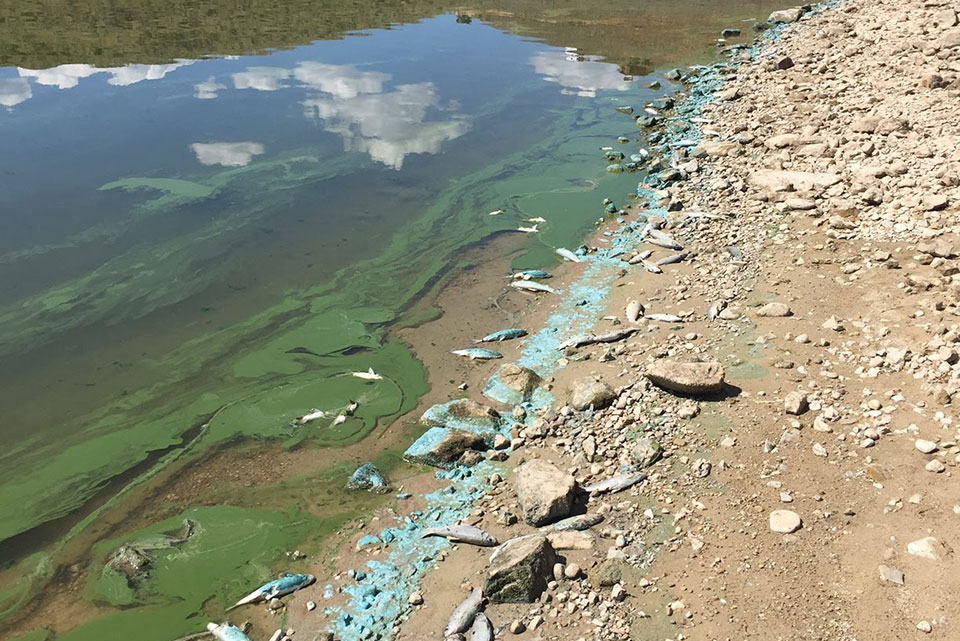 In summertime, Utah Lake is less than crystal clear; the water’s appearance moves from light grey to murky to unnaturally green. As record-breaking temperatures scorch the state, Utah’s ponds, reservoirs and other freshwater bodies, like Utah Lake, are at a higher risk of hosting such harmful algal blooms (HABs). HABs are made from blue-green algae, or cyanobacteria, that are capable of producing toxic products known as cyanotoxins.
In summertime, Utah Lake is less than crystal clear; the water’s appearance moves from light grey to murky to unnaturally green. As record-breaking temperatures scorch the state, Utah’s ponds, reservoirs and other freshwater bodies, like Utah Lake, are at a higher risk of hosting such harmful algal blooms (HABs). HABs are made from blue-green algae, or cyanobacteria, that are capable of producing toxic products known as cyanotoxins.
Cyanotoxins are dangerous for humans and pets—in the summer of 2020, bloom-filled waters killed dogs in Mantua Reservoir and Zion National Park. The issue has gotten worse over time, according to Ramesh Goel, professor of civil and environmental engineering (pictured) who has studied Utah’s harmful algal blooms since 2015. Goel spoke with @theU to discuss the phenomenon and how to stay safe.
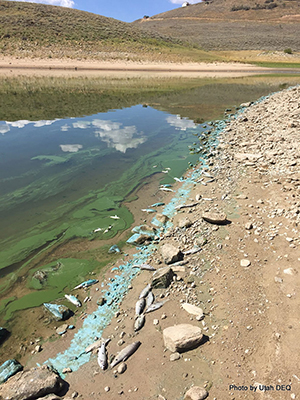
(PHOTO CREDIT: Utah Department of Environmental Quality) A harmful algal bloom (HAB) at Scofield Reservoir in 2016. HABs may leave a blue-green residue along the shorelines.
What is a harmful algal bloom (HAB)?
It’s referring to phytoplankton, the part of the plankton community that makes food from sunlight and are a key part of ocean and freshwater ecosystems. As the name suggests, phyto means light, and phytoplankton survive on light energy and carbon dioxide as a carbon source. Algae is one type of phytoplankton, but not all types of algae are unhealthy. Some blooms are just a nuisance for humans that causes smelly water, lowers water quality, and can kill marine life.
However, toxin-producing blue-green algae, known as harmful cyanobacteria, is very dangerous. Some varieties of cyanobacteria produce what are called cyanotoxins—neurotoxins, hapatotoxins and dermatotoxins, that can cause rashes, seizures, skin cancer and even death. Almost all water bodies tend to have some algae, phytoplankton, and aquatic vegetation. But when cyanobacteria overgrow to the extent that you see it floating in lakes and rivers, or when it turns water very green, then we call them blooms. When these blooms are generating harmful cyanotoxins, like some blue-green algae do, then we call them harmful algal blooms, or HABs.
What causes phytoplankton to grow to dangerous sizes?
The main factors contributing to the blooming are, of course, temperature and nutrients. That’s why climate change is big, big issue. Another factor is carbon dioxide concentrations in the atmosphere, which cyanobacteria use to build up their biomass. Certain types of harmful cyanobacteria thrive in high temperatures and high levels of CO2 concentrations.
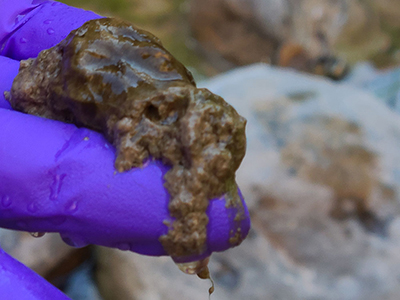
(PHOTO CREDIT: Ramesh Goel) A clump of toxic cyanobacteria in Zion National Park.
Nutrients, mainly nitrogen and phosphorus, flow into freshwater bodies from outside sources. That’s where management and regulation come into the picture. We need to look at all sources—wastewater, stormwater, agriculture runoff, atmospheric deposition—and assess how to limit their contribution to bloom growth.
How does your research address HABs in Utah?
The two areas where I study harmful algal blooms are in Utah Lake and Zion National Park. My lab develops models to predict where and when algal blooms may occur, now and in the future, by using genomic tools to understand the ecology and functioning of cyanobacterial blooms. Our ultimate goal is to predict the occurrence of HABs as an early warning tool. The modeling effort is led by another colleague Dr. Mike Barber in the civil engineering department.
When I moved to Salt Lake City in 2005, there wasn’t much surrounding Utah Lake. Now you see a lot of urban development far into those mountains. Development causes formerly natural surfaces to become impervious, so you have more runoff coming into the lake environment rather than going into groundwater and getting into the soil.
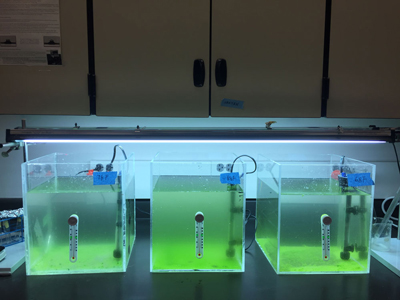
(PHOTO CREDIT: Ramesh Goel) Ramesh Goel tests how toxic cyanobacteria responds under different temperatures. From left to right, the temperatures are 78, 88 and 68 degrees Fahrenheit
More runoff means more nutrients from all these developed spaces. With funding from the U.S. Environmental Protection Agency, we’re looking to see how lake water quality is going to change—as a consequence of this urban development, as a consequence of more nutrients coming in, and as a consequence of climate change leading to elevated temperatures and CO2 levels.
And things are changing. In general, the paradigm for blooms is that cyanobacteria or algae, they tend to grow more in stagnant waters like lakes or ponds. But last year, we heard of a dog dying suddenly in a small stream off of the Virgin River in Zion National Park. He went to this stream, maybe just a foot deep, and splashed and maybe drank water. Then, he had seizures, and died on spot. The Park did sampling and found very high concentrations of dangerous cyanotoxins. The World Health Organization’s limit is below 10 microgram per liter, but the concentrations last July was more than 150, 130 microgram per liter. And the concentrations got really high again in March of this year.
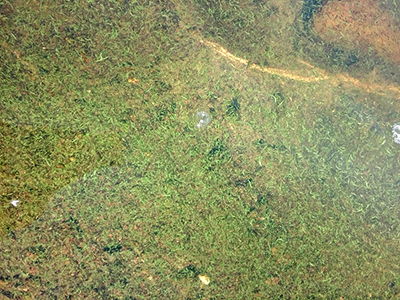
(PHOTO CREDIT: Utah Department of Environmental Quality) A harmful algal bloom (HABs) in Upper Box Creek. HABs may resemble grass clippings floating on the top of the water.
Are HABs getting worse everywhere?
I am collaborating with researchers from California, Switzerland and New Zealand to look into this. Surprisingly, one dog also died from drinking water in a stream in Switzerland last year. Coincidentally, it is the same species of cyanobacteria that caused blooming in Zion Nation Park. And people have found it in Russia also—the same species of cyanobacteria, under the same conditions, it grows and generates this high concentration of cyanotoxins. We’ll be looking into under what conditions they generate these toxins? What happens? Are they synergizing their efforts with other nontoxic bacteria? These are some of the fundamental questions we are investigating, and we’ll be submitting proposals to National Science Foundation and other places.
How can people keep themselves and their pets safe?
Anything green is bad. If you see things floating or even if you don’t see things but the water is too green, don’t get in. These are bacteria, right? When things are floating, then it’s algae or perhaps filamentous cyanobacteria. But if water is green, that means they’re the cyanobacteria growing and dispersed in the water column. People should not swim there. Green means it could be nasty stuff, at least.
Be extra careful this summer. A few degrees of temperature change can create miracles for algae and cyanobacteria. Another thing is, because we are in drought and have very high temperatures, it causes water to evaporate. Utah Lake is losing water. When the water level is going down, things are getting more concentrated in the lake. Just as an example, 5 milligram per liter now becomes 6 milligram per liter. That difference can cause cyanobacteria to grow. - Lisa Potter, Research Communications, University of Utah
Related Posts
- Student Awarded Utah Water Users Association Scholarship
Youcan Feng, Ph.D. candidate in water resources, received one of this year's Utah Water Users…
- Faculty Receives Award from Utah Department of Transportation
Dr. Pedro Romero, faculty in Civil Engineering, was presented with the Utah Department of Transportation…
- Student Receives Award from the Utah Asphalt Paving Association
Abu Sufian Mohammad Asib, a Ph.D. candidate in Transportation under the supervision of Dr. Romero,…

